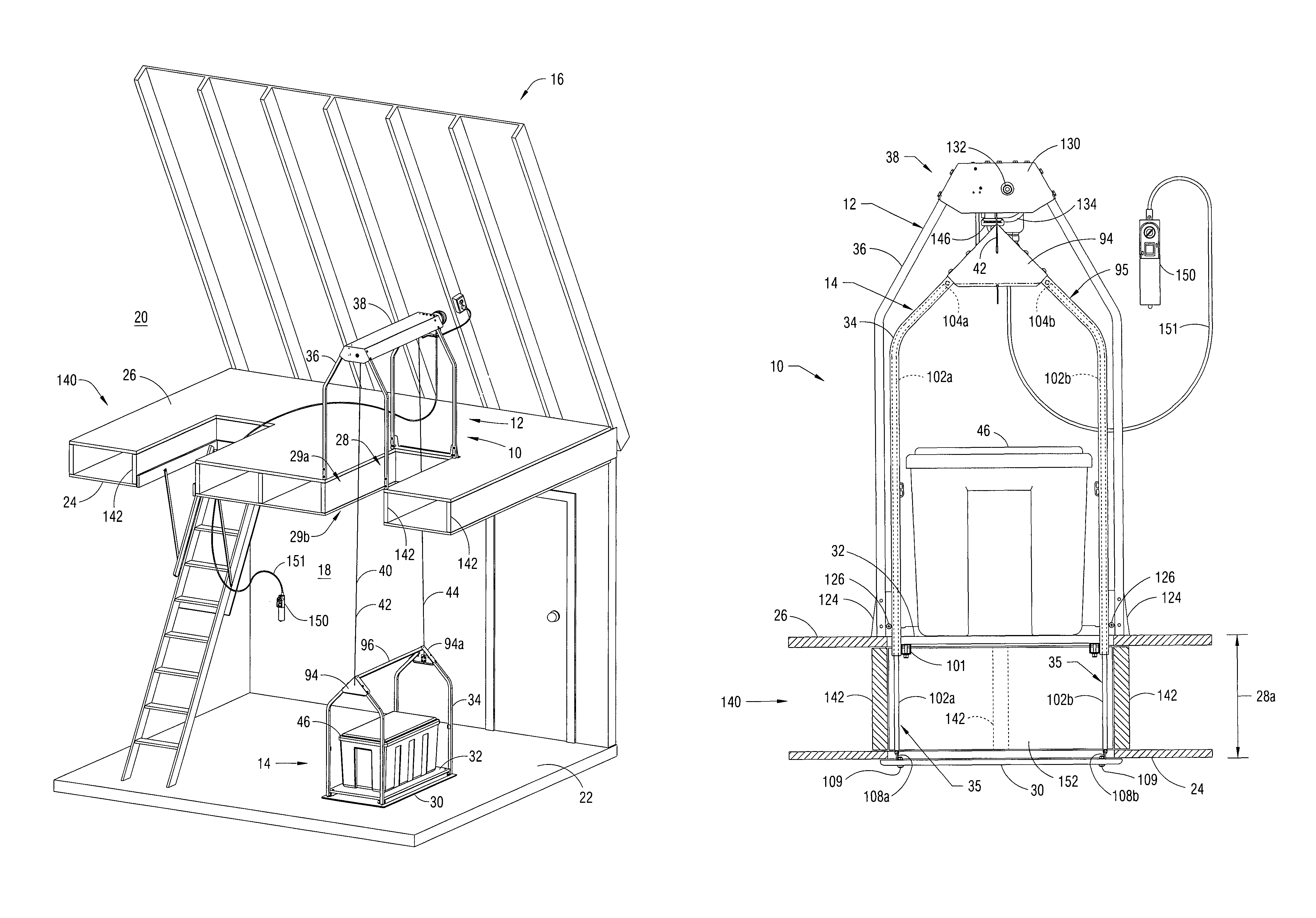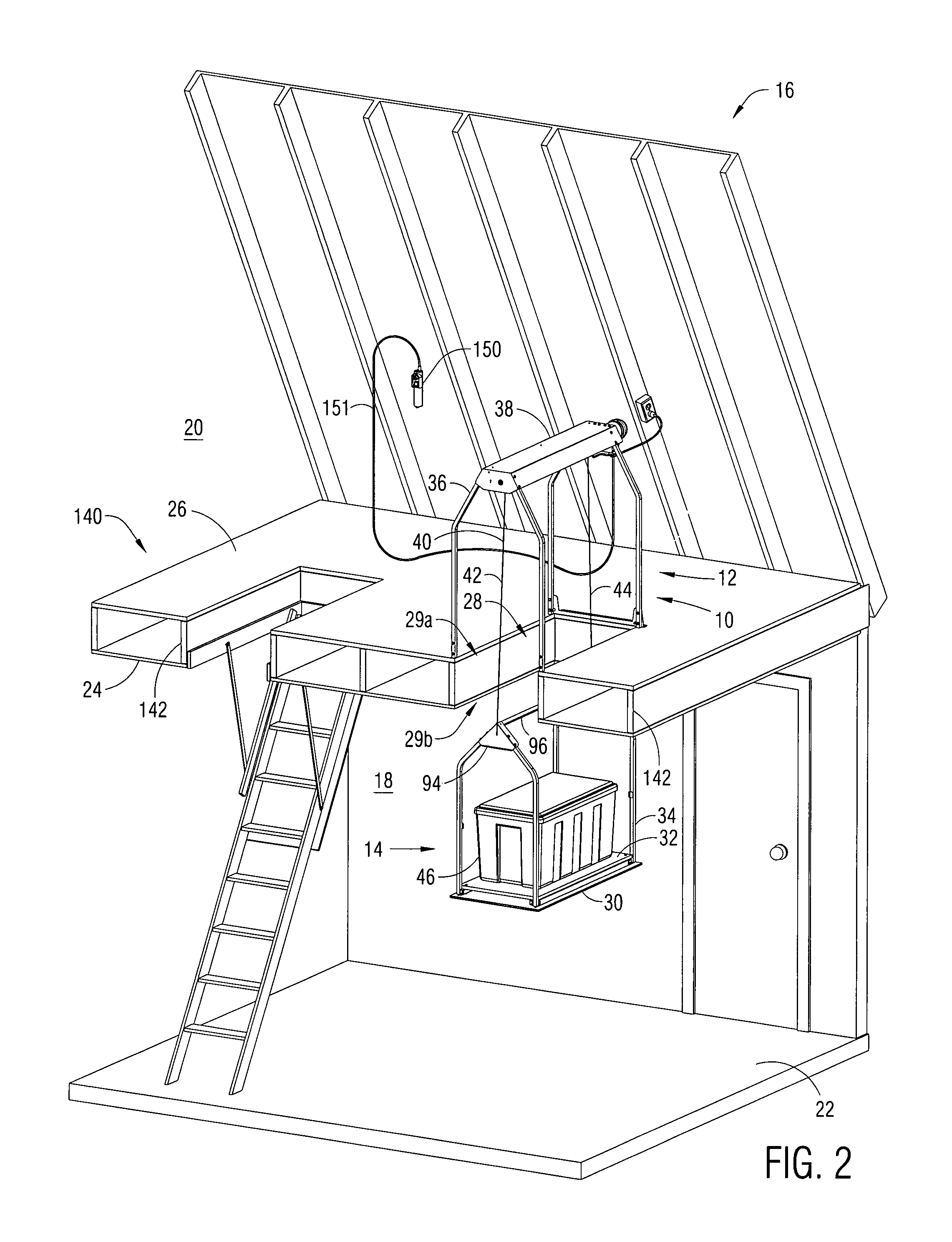As stairs are narrow and steep, moving large or heavy boxes and other bulky items up stairs presents a difficult and often dangerous task.
The problem that has long existed is that
attic storage space is normally accessible only by a fold-down ladder (which is often flimsy or unstable) or stairway that is both steep and narrow and sometimes slick.
Climbing one of these ladders is dangerous enough with both
hands free.
Trying to carry boxes and other heavy or bulky items up or down is virtually impossible to do and usually requires two persons: one pushing from below and the other pulling from above.
This is extremely dangerous and can result in serious accidental injury.
However, elevators are complex devices that must be installed by skilled engineers, electricians and contractors and are therefore very expensive.
The cost is too high to be afforded by the average home owner.
In particular, there are a number of specific problems associated with the lift systems of the prior art which are encountered by the users of such systems.
These are identified below and bear on issues of safety, affordability, effectiveness, simplicity, and installability.1. Prior art lift systems often require an excessive amount of skilled labor to install.
Often, installation requires hiring an electrician to install special wiring, which can be costly.
The systems often require specially trained persons to make custom modifications to the apparatus to fit each individual installation.2. Prior art systems are seldom readily adaptable to a wide variety of ceiling heights, and
rafter (
joist) dimensions.
Ceiling joists range from 2×4 inches to 2×12 inches in lumber and from 2×14 inches to 2×36 inches in fabricated joists and laminated beams, thus causing wide variation in the thickness of the ceiling opening that the lift device must be adapted to fit through.3. Prior art systems often require roller guide tracks, telescoping columns, rails or other expensive and cumbersome guide means.
Telescoping columns are inherently costly.
Guide track and rails are also costly as well as unsightly.
These devices are not readily adaptable to widely different ceiling heights and other structural variations and often require the device to be custom built or to be specifically modified to fit each particular installation.4. Prior art systems lacking such guide means, however, cannot reliably guide themselves and the maximum load into and out of the ceiling opening.
The platform assembly of the prior art systems often incur misalignment between the ceiling opening and the platform assembly when loaded to capacity so that the platform or cargo thereon catches on the edge of the ceiling opening and cannot pass through the opening.5. Systems of the prior art are often not completely installable with ordinary tools and often do not include a reliable means to adjust the length of the cables for each installation using ordinary tools.
Typically, cables used in these systems must be modified to have permanently swaged sleeves forming loops at each end and are not adjustable.
These systems do not include a secure and easily adjustable means to connect the cables which depends only ordinary tools common to home owners.6. Most prior art systems leave the opening in the ceiling open whenever it is not in use (in the raised position).
This is esthetically unpleasing and leads to loss of heating or cooling into the attic space, and allows access by unwanted entry of insects and small animals from the attic space into the home.7. Other prior art systems that close the opening in the ceiling do not elevate the storage items level with the floor above the opening and would require lifting of the storage items manually merely to remove them from the platform and onto the floor surface or vice versa.
This increases the chance of back injuries, and is inconvenient to the home owner, substantially reducing the usefulness of such a lifting device.8. Prior art systems often provide unstable lifting platforms thus rendering them less capable of safely lifting a variety of objects of different sizes and weights.
For example the lifting platform of these systems is often designed in such a way to increase the risk of becoming top heavy when loaded with large objects, creating a potential
hazard of tipping over and spilling the load off of the platform.9. Systems of the prior art may not stop automatically when raised to the highest position, sometimes causing the
system to be stressed or jammed when it reaches the uppermost limit of its travel.
Similarly these systems may not automatically stop as close to level (flush) with the attic floor as possible, unless the operator releases the switch at an exactly optimal instant.
This can lead to tangling or
fouling and may leave the cable requiring repair.
Systems which do have automatic downward stopping mechanisms require a mechanism of considerable complexity and expense due to the necessity of routing wires to a moving platform or employing a
wireless remote switching device and may require installation and setting by a trained installer.11.
This causes a vitally unsafe situation.
If the platform becomes lodged while the cable continues to pay out the cables will accumulate slack, possibly becoming fouled or jammed.
Then if the platform is dislodged while the cables are slack, it can free-fall some distance from the opening, possibly spilling the load or even breaking the cable, causing costly damage and possible serious personal injury.12.
The platform assemblies of prior art systems tend to flip over and thereby spill the load whenever one of the cables becomes jammed while the other cables continue to pay out.
If this occurs, costly damage and serious personal injury is possible.13.
Many prior art systems do not include a momentary switch for safety so that the lifting mechanism will stop immediately when the switch is released by the operator and do not include a security locking device to prevent unauthorized use, for example, by children.14.
Systems which are installed where the
upper floor is a
living space occupied by or accessible to
small children, often leave the opening in the
upper floor open when the platform is lowered, potentially allowing a person or child to inadvertently step or fall through the opening to the floor below likely suffering serious injury or death.15.
Prior art systems are often too costly to be affordable to the average home owner, while still meeting the stated minimum needs and requirements and may be unnecessarily complex thereby adding cost without adding benefits or usefulness.
A number of prior art systems require tracks or telescoping columns to guide the platform and would be inherently complex and costly while not readily adapting to different heights and locations.
This arrangement will support vertical loads but lacks dynamic stability.
Large loads on such systems will inherently become unstable if the platform becomes tipped due to an obstruction or any
fouling or jamming of one of the supporting cables.
Once the platform and load thereon become unbalanced, the platform could flip completely over, dumping the load.
This is because cables or tethers can
resist downward forces but cannot
resist the upward forces created by an unbalanced platform.
In addition to the balance problem, supporting the platform directly with four cable attachment points as taught in the prior art, leaves another important safety problem unsolved.
When this occurs, the load and platform can become jammed or the load spilled.
While some of the prior art systems make vague references to limit switches that would stop the lifting platform when it reaches the lower floor, none have provided a specific solution to the problem of how to implement these
lower limit switches while suitably managing the associated wiring.
Penn fails to demonstrate a plausible means to connect the switches in the underside of the movable platform with the drive mechanism above.
Penn also fails to show how to
mount a switch on the lowest end of a folding ladder and how to safely manage the wiring through a series of joints in the ladder that fold and could pinch or
cut the wires.
Both of these approaches would be inherently problematic, difficult and costly to implement.
Also, the platforms of the prior art systems often leave the raised, loaded platform substantially below the
upper floor surface, causing the user to lean over the opening and lift out the storage items.
This could be difficult and dangerous with heavy items.
That would require the user to do much lifting to load and unload the elevated platform causing much inconvenience to the home owner while increasing the risk of
back injury.
Further, none of the prior art systems has provided a practical means to automatically halt the apparatus in the event the platform assembly becomes jammed or lodged in the ceiling opening while descending.
More over, none of the prior art has provided a practical means to automatically halt the apparatus in the event one cable should become jammed or fouled while the platform is descending.
 Login to View More
Login to View More  Login to View More
Login to View More 


